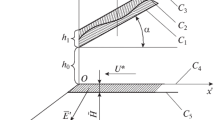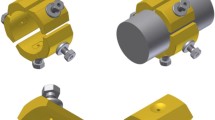Abstract
It is found that the load capacity of a magnetohydrodynamic thrust bearing with a rotating disk can be increased by rotating the axial magnetic field at a suitable speed in a direction opposite to that of the disk rotation. This method of improving the bearing performance is considered to be efficient if the Hartmann number is not too large. Thus for a given load, the size and weight of the magnet to be used in a thrust bearing with rotating field can be reduced considerably.
Similar content being viewed by others
Abbreviations
- a :
-
radius of plenum recess
- b :
-
outside disk radius
- B 0 :
-
magnetic induction of applied axial magnetic field
- Ē :
-
hE 0 σ 1/2/aωμ 1/2, nondimensionalized electric field
- E 0 :
-
radial electric field at r=a
- E r :
-
radial electric field
- h :
-
half of lubricant film thickness
- M :
-
(σB 20 h 2/μ)1/2, Hartmann number
- P :
-
pressure
- P e :
-
pressure at r=b
- P 0 :
-
pressure at r=a
- Q :
-
volume flow rate of lubricant
- Q 0 :
-
volume flow rate of a nonrotating bearing in the absence of applied magnetic field
- r :
-
radial coordinate
- u, v :
-
fluid velocity components in radial and circumferential directions, respectively
- W :
-
load capacity of bearing
- W 0 :
-
load capacity of a nonrotating bearing in the absence of a magnetic field having a flow rate which the same bearing would have at Hartmann number M
- z :
-
axial coordinate
- θ :
-
azimuthal coordinate
- μ :
-
coefficient of viscosity of lubricant
- μ e :
-
magnetic permeability
- ρ :
-
fluid density
- σ :
-
electrical conductivity
- ω :
-
angular velocity of rotating disk
- ω C :
-
critical disk velocity at which W=0
- ω M :
-
angular velocity of axial magnetic field
- \((\omega _{\text{M}} )_{{\text{opt}}}\) :
-
optimum angular velocity of magnetic field
References
Hughes, W. F. and R. A. Elco, J. Fluid Mech. 13 (1962) 21.
Maki, E. R., D. C. Kuzma, and R. J. Donnelly, J. Fluid Mech. 26 (1966) 537.
Krieger, R. J., H. J. Day, and W. F. Hughes, J. Lubr. Tech. Ser. F. Trans. ASME 89 (1967) 307.
Ramanaiah, G., Appl. Sci. Res. A17 (1967) 305.
Chow, C. Y., Appl. Sci. Res. 20 (1969) 40.
Osterle, J. F. and W. F. Hughes, Wear 1 (1958) 465.
Author information
Authors and Affiliations
Additional information
On leave of absence from Department of Aero-Space Engineering, University of Notre Dame, Notre Dame (Ind.), U.S.A.
Rights and permissions
About this article
Cite this article
Chow, CY., Brunell, R.D. A rotating field mhd hydrostatic thrust bearing. Appl. sci. Res. 21, 206–217 (1969). https://doi.org/10.1007/BF00411608
Received:
Revised:
Issue Date:
DOI: https://doi.org/10.1007/BF00411608




